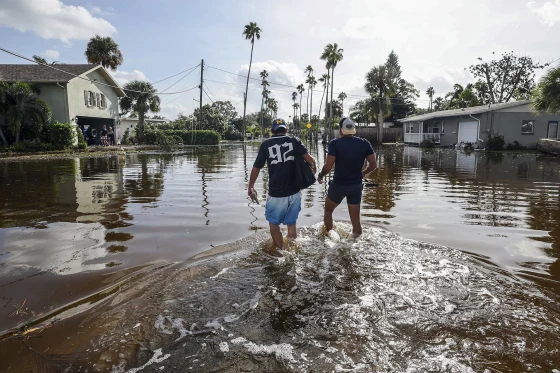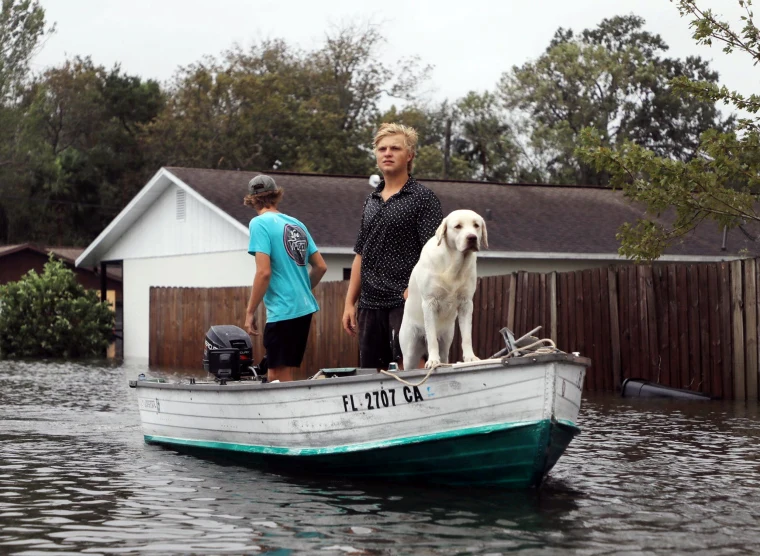ORLANDO, Fla. — The news surged through Treasure Island, Florida, akin to a third storm: Mayor Tyler Payne announced plans to leave the barrier island just a month after Hurricane Helene inundated thousands of homes along the Gulf Coast and two weeks after Hurricane Milton wreaked further havoc in the state.
In a message to the residents of Treasure Island, Mayor Payne shared that both his home and his husband’s had suffered severe flooding and damage, rendering them beyond repair. He expressed that rebuilding was financially unfeasible for them. Alongside this decision, Payne also revealed his resignation from the mayoral position. “While it pains my heart to make this decision during our recovery from Hurricanes Helene and Milton, this choice is best for my family and me,” said Payne, who had served as mayor for over three years and had deep roots as a fourth-generation resident of Treasure Island.
Throughout Florida’s storm-impacted Gulf Coast, countless residents grapple with similar dilemmas about their future. They weigh their ability to afford rebuilding against the backdrop of recent destruction. They ask themselves what their insurance will cover and whether they can recover from the devastation. Prospective newcomers to Florida also ponder whether moving to a hurricane-prone state is worth the risk.
These profound questions about Florida’s allure resurface after every tumultuous hurricane season. The memory of the 2004 season, when four hurricanes tore through the Sunshine State, lingers in the minds of many. Yet, if population growth is any indication, hurricanes do not deter people from settling in Florida. Over the past two decades, the state’s population has surged by one-third, reaching 23 million residents. In the past year alone, Florida welcomed more than 365,000 new residents, trailing only Texas in state population growth.

Conversely, signs indicate that Florida’s once-booming real estate market is beginning to cool. In September, sales of single-family homes fell by 12% compared to the same month the previous year. Factors like rising interest rates, increasing home prices, and soaring insurance costs appear to have a more significant impact than the recent hurricanes on the market dynamics.
“Florida recovers much faster than you think,” stated Brad O’Connor, chief economist for Florida Realtors. He highlighted that the state has a resilient economy and a robust housing market, which can bounce back more quickly than expected after disasters.
Despite the challenges, many Floridians remain committed to their communities. They draw strength from their shared experiences and the collective spirit that arises during recovery efforts. Neighbors help one another, forging deeper connections amidst the struggle to rebuild their lives.
While some families face the prospect of leaving their homes, others choose to stay and face the challenges head-on. They believe in the potential of recovery and the beauty of their coastal lifestyle, which often outweighs the risks. Many residents find solace in their long-standing ties to the area, choosing to weather the storms together.
For some, the hurricanes serve as a stark reminder of nature’s power, but they also highlight the community’s resilience. People come together in times of crisis, reinforcing their determination to rebuild and restore what was lost. The love for their homes and the support of their neighbors embolden them to confront the uncertainties ahead.
As Florida navigates this period of reflection and recovery, questions about safety and stability will continue to resonate. Residents and newcomers alike will weigh the risks against the rewards of living in this vibrant state. The allure of sunny beaches, thriving culture, and economic opportunities remain compelling, even in the face of adversity.
In this ongoing conversation about resilience and recovery, the story of Mayor Payne is emblematic of a larger narrative. As individuals and families contemplate their futures in a hurricane-prone region, they balance their hopes and fears with practical considerations about safety and security.
Ultimately, the decisions made by residents of Treasure Island and beyond will shape the future of Florida. While the specter of hurricanes looms large, the spirit of community and the desire to thrive amid challenges will guide them as they forge ahead.
What Happens After a Storm?
Studies of hurricanes along the Gulf Coast reveal that any outbound migration tends to be brief. When people do leave, they often relocate only short distances, such as moving from a barrier island to the mainland. Older individuals with more financial resources generally show a higher likelihood of returning to their devastated communities.
In the aftermath of a hurricane, the housing market experiences an initial shock. Homeowners often delay repairs or sales while waiting for reimbursements from insurance companies. This temporary pause can create a scarcity of available homes.
However, over the three years following a hurricane, home prices in affected areas of Florida typically rise. On average, these prices increase by 5% compared to other parts of the state. A study examining the impact of hurricanes on Florida’s housing market from 2000 to 2016 confirms this trend, attributing the price hike to the limited housing supply.
As the recovery unfolds, new homeowners often possess greater wealth than those they replace. Wealthier buyers can more readily absorb price increases, contributing to the rising market values in hurricane-stricken areas.
Several factors influence how quickly communities recover after a storm. The extent of insurance coverage, the speed of reimbursement, and the availability of construction workers all play crucial roles. Areas with more insured properties tend to bounce back more rapidly.
Following the devastation of Hurricane Andrew in 1992, stricter building codes emerged in South Florida. These updated regulations allow newer homes to withstand hurricanes more effectively than their older counterparts, significantly reducing potential damage.
“If a property is damaged and uninsured, the homeowner might decide, ‘I don’t want to deal with this,’” said O’Connor. “In such cases, there are always buyers ready to purchase that valuable land.” Investors and builders see opportunity in these situations, leading to new constructions under the improved codes.
The influx of new homes helps mitigate the long-term impact of hurricanes on the community. As new developments rise, neighborhoods can regain their vibrancy and attract more residents.
Ultimately, the cycle of recovery and rebuilding fosters resilience in these communities. As they adapt to the challenges posed by natural disasters, they create environments that can better withstand future storms.
In this ongoing process, both the housing market and the social fabric of the community transform, illustrating the complex interplay between disaster and recovery in hurricane-prone regions.
Short Term and Long Term: Community Impact After Storms
Recent storms illustrate the effects on communities in both the short term and long term.
In Lee County, home to Fort Myers, Hurricane Ian made landfall two years ago in one of the fastest-growing regions of the United States. Following the storm, population growth slowed significantly from 4.4% to just 1.5%. According to the U.S. Census Bureau, the number of households also declined, dropping from approximately 340,000 to about 326,000.
In 2019, three-quarters of all United Van Lines truck moves involved people moving into Lee County, while only a quarter moved out. However, between 2023 and 2024, this ratio shifted to two-thirds inbound and one-third outbound, according to the company’s report to The Associated Press.
Demographic changes have also occurred. The share of residents in their late 20s, 30s, and early 40s has increased, alongside a rise in the number of single men. This shift reflects the influx of construction and recovery workers drawn to the area. Additionally, while the white population share has decreased, the Hispanic community has grown, indicating a changing demographic landscape.
In contrast, Bay County in the Florida Panhandle presents a picture of longer-term trends following Hurricane Michael, which struck as the first Category 5 hurricane on the continental U.S. in a quarter-century in 2018. Four years post-storm, Bay County regained its pre-hurricane population, which had dipped by nearly 6% in the immediate aftermath.
Since Hurricane Michael, Bay County has become more diverse, wealthier, and older. The median age has risen from 39.6 to 41.4 years. More residents now identify as multiracial or Hispanic, reflecting shifts in the community’s composition.
Economic changes also reveal significant trends. The percentage of households earning $200,000 or more increased from 4.3% before the hurricane to 8.3% in 2022. This rise suggests that some of the least affluent residents faced challenges in affording to rebuild or return to the area.
Both counties demonstrate the multifaceted impacts of storms. In the short term, hurricanes can disrupt population growth and alter demographic structures. In the long term, communities may evolve in ways that reflect changing economic conditions and social dynamics.
As these areas recover, the community fabric shifts. New residents and industries emerge, reshaping the landscape and influencing future growth patterns.
Overall, the experiences of Lee County and Bay County illustrate how communities respond to and recover from storms, highlighting the complex interplay between immediate effects and long-term changes.
In his message to constituents, Mayor Tyler Payne expressed his intention to remain connected to the Treasure Island community, noting that his parents plan to rebuild on the barrier island. This area, known for its motels, restaurants, and bars, lies along the Gulf of Mexico west of St. Petersburg. Payne, an attorney and executive in his family’s eyeglass-lenses manufacturing business, described his decision to move as “difficult.”
Payne emphasized his understanding of the challenges that many residents face in the aftermath of recent storms. “I completely empathize with the difficult decisions that are confronting so many of our residents,” he stated.
Despite his departure from the mayoral office, Payne’s commitment to the community remains strong. He plans to stay involved and support local initiatives, recognizing the importance of unity during recovery efforts.
As Treasure Island navigates the rebuilding process, Payne’s insights and experiences can provide valuable guidance. His ongoing connection to the community will help bridge the gap between the past and the future for residents facing tough choices.
In this challenging time, Payne’s message of empathy and support resonates with the community, reinforcing the bonds that hold Treasure Island together as it works toward recovery.

